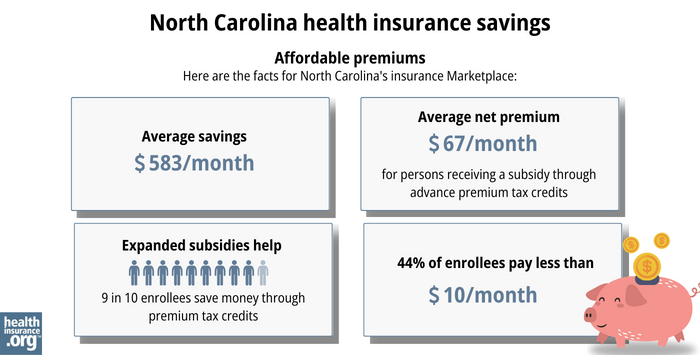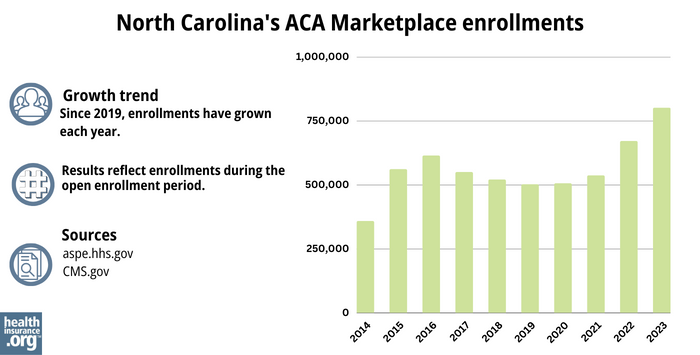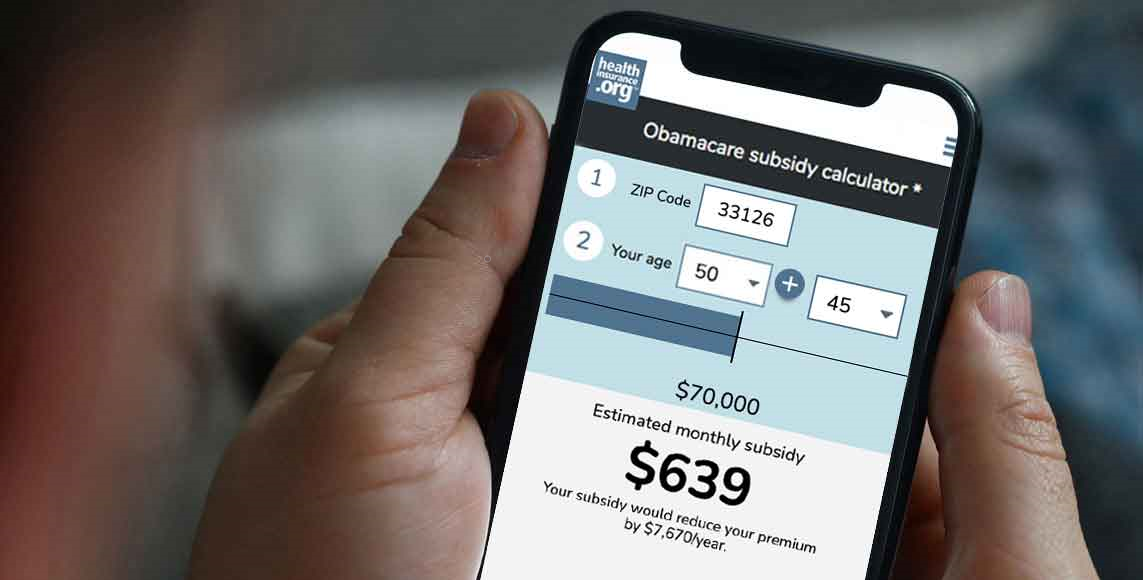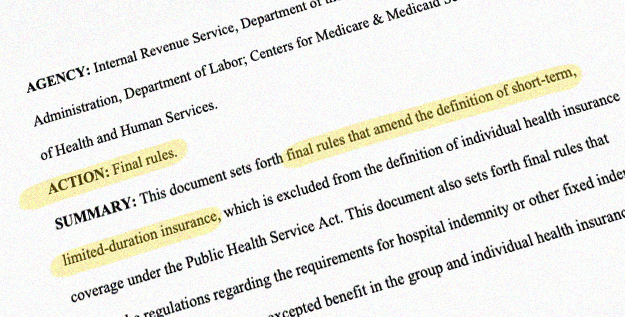Home > States > Health insurance in North Carolina
See your North Carolina health insurance coverage options.

Find individual and family plans, small-group, short-term or Medicare plans through licensed agency partners.

North Carolina Health Insurance Consumer Guide
This guide was developed to help you understand the health coverage options and possible financial assistance available to you and your family in North Carolina. The options found in North Carolina’s ACA Marketplace may be a good choice for many consumers, and we will guide you through the options below.
North Carolina uses the federally run health insurance exchange Healthcare.gov for residents to purchase its ACA Marketplace plans. The Marketplace provides access to health insurance products from private insurers.
The federal government helps pay for insurance through an advance premium tax credit if you buy coverage from the exchange and are eligible for the tax credit based on your income. Some enrollees are also eligible for cost-sharing reductions, which reduce out-of-pocket costs on Silver-level plans for eligible enrollees.
North Carolina Medicaid expansion took effect on December 1, 2023, making hundreds of thousands of North Carolina residents newly eligible for Medicaid. Some were previously in the coverage gap, while others were previously eligible for subsidies to offset the cost of Marketplace coverage.1
Explore our other comprehensive guides to coverage in North Carolina
Dental coverage in North Carolina

Need dental coverage? Learn about available options and find the right dental plan in North Carolina with our guide.

North Carolina’s Medicaid program

North Carolina has not yet expanded Medicaid eligibility under the Affordable Care Act (ACA), but that will change in the coming months. State lawmakers passed legislation which was signed into law in March 2023 that calls for Medicaid expansion in the state to take effect by the end of the year.2 There were 2,372,919 people enrolled in the North Carolina Medicaid program as of April 2023.3

Medicare coverage and enrollment in North Carolina

As of February 2023, there were 2,142,905 residents with Medicare in North Carolina.4 Our guide will help you understand Medicare Parts A, B, C and D – as well as Medicare supplement (Medigap) plans available in North Carolina.

Short-term coverage in North Carolina

In North Carolina, consumers can buy short-term health insurance plans with initial policy terms of up to 364 days with the option to renew for a total duration up to 36 months. As of 2023, there were at least eight insurers selling short-term health insurance plans in North Carolina.5

Frequently asked questions about health insurance in North Carolina
Who can buy Marketplace health insurance?
To qualify for health coverage through the North Carolina Marketplace, you must:6
- Live in North Carolina
- Be lawfully present in the United States
- Not be incarcerated
- Not be enrolled in Medicare
Eligibility for financial assistance (premium subsidies and cost-sharing reductions) depends on your income and how it compares with the cost of the second-lowest-cost Silver plan in your area – which depends on your age and location. In addition, to qualify for financial assistance with your Marketplace plan you must:
- Not have access to affordable health coverage through your employer. If your employer offers coverage but you feel it’s too expensive, you can use our Employer Health Plan Affordability Calculator to see if you might qualify for premium subsidies in the Marketplace.
- Not be eligible for Medicaid or CHIP, or premium-free Medicare Part A.
When can I enroll in an ACA-compliant plan in North Carolina?
In North Carolina, the open enrollment period for individual/family health coverage runs from November 1 to January 15.7 (For 2024 coverage, the deadline was extended to January 16, 2024, due to the federal holiday on January 15.)8
Your coverage will start on January 1 if you enroll before December 15. But if you apply between December 16 and January 16, your coverage will begin on February 1.9
Outside of open enrollment, a qualifying event is generally necessary to enroll or make changes to your coverage, although some people can qualify for a special enrollment period without a specific qualifying life event.
If you have questions about open enrollment, you can learn more in our comprehensive guide to open enrollment. We also have a comprehensive guide to special enrollment periods.
How do I enroll in a North Carolina Marketplace plan?
If you’re eligible for an ACA Marketplace plan, there are several ways you can enroll:
- Online through HealthCare.gov
- By phone at (800) 318-2596
- With local help in your community from an agent/broker, Navigator, or certified application counselors (these individuals are available to help you over the phone, online, and sometimes in-person, depending on your preference)
- Through an approved enhanced direct enrollment entity.10
How can I find affordable health insurance in North Carolina?
North Carolina uses the federally run exchange for individual market plans, so residents who buy their own health insurance enroll through HealthCare.gov.
More than nine out of ten eligible enrollees save money on premium payments amounting to an average savings of $583/month. After subsidies were applied, the average enrollee’s monthly cost was about $67/month.11
The Affordable Care Act provides income-based advance premium tax credits (subsidies) that offset your premium payments to help keep your expenses down. People with household incomes up to 250% of the federal poverty level also qualify for cost-sharing reductions (CSR) that may reduce your deductibles and out-of-pocket expenses when you buy a Silver plan. In 2023, more than half of North Carolina Marketplace enrollees were receiving CSR benefits.12
Between the premium subsidies and cost-sharing reductions, you may find that an ACA plan is the most affordable and robust health insurance option for you.

Source: CMS.gov 13
How many insurers offer Marketplace coverage in North Carolina?
Nine insurers offer exchange plans in North Carolina, with coverage areas that vary from one insurer to another.14
The federal Marketplace insurer participation map shows North Carolina having one fewer Marketplace insurer in 2024 than they had in 2023.15 However, based on an analysis of the Marketplace landscape files, that’s because Friday Health Plans participated in the Marketplace in 2023 and will not in 2024.16
However, all Friday Health Plans policies in North Carolina terminated at the end of August 2023, so people no longer had coverage under those plans when open enrollment began for 2024 coverage. All of the other insurers are continuing to offer coverage in the North Carolina Marketplace for 2024.
Are Marketplace health insurance premiums increasing in North Carolina?
There are nine insurers offering plans in North Carolina’s marketplace for 2024. The following average rate changes were approved for 2024:
North Carolina’s ACA Marketplace Plan 2024 Approved Rate Increases by Insurance Company |
|
|---|---|
| Issuer | Percent Increase |
| Aetna Health Inc. | 2.44% |
| Ambetter/Centene | 0.96% |
| AmeriHealth Caritas | 0.00% |
| Blue Cross and Blue Shield of NC | -4.04% |
| Celtic/WellCare | 6.2% |
| Cigna | 7.23% |
| Oscar | 5.5% |
| UnitedHealthcare | -8.16% |
| CareSource | -3.39% |
Source: North Carolina Department of Insurance17
The overall average approved rate change represents a 1.3% reduction in individual market premiums for 2024.18
For perspective, here’s a summary of how average unsubsidized premiums have changed each year in North Carolina’s individual/family market:
- 2015: Average increase of 12%.19
- 2016: Average increase of 28.1%.20
- 2017: Average increase of 24.3%.21
- 2018: Average increase of 14.8%.22
- 2019: Average decrease of 3.9%23
- 2020: Average decrease of 5.6%.24
- 2021: Average preliminary increase of 4%.25
- 2022: Average increase of 3.2%.26
- 2023: Average increase of 7.93%27
How many people are insured through North Carolina’s Marketplace?
By December 23, 2023, when there were still a few weeks remaining in the open enrollment period for 2024 coverage, enrollment in North Carolina Marketplace plans had already reached 996,250 people.28
This was by far a record high (see chart below for enrollment in prior years), even though Medicaid expansion took effect in North Carolina in December 2023.
Before Medicaid expansion, people with income between 100% and 138% of the poverty level were eligible for Marketplace subsidies, whereas they’re now eligible for Medicaid instead. So states tend to see a dip in their Marketplace enrollment after expanding Medicaid. But North Carolina’s enrollment has instead climbed to a significant new record high for 2024.
The increase in enrollment (which has been ongoing in North Carolina since 2021) is driven in part by the American Rescue Plan (ARP). Under the ARP, ACA’s premium subsidies are larger and more widely available. The ARP’s subsidy enhancements have been extended through 2025 by the Inflation Reduction Act.29
The increase is also due to the “unwinding” of the pandemic-era Medicaid continuous coverage rule. Between June and December 2023, nearly 200,000 people in North Carolina were disenrolled from Medicaid.30 By September, 40,684 of these individuals had transitioned to Marketplace coverage.31

Source: 2014,32 2015,33 2016,34 2017,35 2018,36 2019,37 2020,38 2021,39 2022,40 202341 202341
What health insurance resources are available to North Carolina residents?
HealthCare.gov
800-318-2596
State Exchange Profile: North Carolina
The Henry J. Kaiser Family Foundation overview of North Carolina’s progress toward creating a state health insurance exchange.
North Carolina Institute of Medicine (NCIOM)
Health Insurance Smart NC
Assists people insured by private health plans, Medicaid, or other plans in resolving problems pertaining to their health coverage; assists uninsured residents with access to care.
Toll free: 1-877-885-0231
Managed Care Patient Assistance Program
Serves consumers who are members of managed health benefit plans.
(919) 733-6272 / Toll-Free: 1-866-867-6272 (in North Carolina only)
[email protected]
Community Care of North Carolina
Legal Aid of North Carolina (855-733-3711)
Louise Norris is an individual health insurance broker who has been writing about health insurance and health reform since 2006. She has written dozens of opinions and educational pieces about the Affordable Care Act for healthinsurance.org.
Footnotes
- Questions and Answers about Medicaid Expansion. North Carolina Medicaid Division of Health Benefits. Accessed November 2023. ⤶
- “NC H76” BillTrack50, Accessed August 2023 ⤶
- “April 2023 Medicaid & CHIP Enrollment Data Highlights“ Medicaid.gov ⤶
- “Medicare Monthly Enrollment“ CMS.gov, Accessed August 2023 ⤶
- “Availability of short-term health insurance in North Carolina” healthinsurance.org, Sept. 23, 2022 ⤶
- ”A quick guide to the Health Insurance Marketplace” HealthCare.gov ⤶
- “When can you get health insurance?” HealthCare.gov, 2023 ⤶
- Biden-Harris Administration Launches Window-Shopping Ahead of 11th ACA Marketplace Open Enrollment Period. Centers for Medicare and Medicaid Services. October 25, 2023. ⤶
- “When can you get health insurance?” HealthCare.gov, 2023 ⤶
- “Entities Approved to Use Enhanced Direct Enrollment” CMS.gov, April 28, 2023 ⤶
- “2023 Marketplace Open Enrollment Period Public Use Files” CMS.gov, 2023 ⤶
- “Effectuated Enrollment: Early 2023 Snapshot and Full Year 2022 Average” CMS.gov, March 15, 2023 ⤶
- “2023 OEP State-Level Public Use File” CMS.gov, March 23, 2023 ⤶
- North Carolina Department of Insurance – Life & Health Division Health Insurance Rate Change Requests for 2024 for Individual Policies (Approved) North Carolina Department of Insurance. Accessed November 2023. ⤶
- Plan Year 2024 Qualified Health Plan Choice and Premiums in HealthCare.gov Marketplaces. Centers for Medicare and Medicaid Services. October 25, 2023 ⤶
- FFM QHP landscape files: Health and dental datasets for researchers and issuers; 2024 plan data. HealthCare.gov. Accessed November 2023. ⤶
- North Carolina Department of Insurance – Life & Health Division Health Insurance Rate Change Requests for 2024 for Individual Policies (Approved) North Carolina Department of Insurance. Accessed November 2023. ⤶
- North Carolina: *Final* Avg. Unsubsidized 2024 #ACA Rate Changes: -1.3% (Updated). ACASignups.net, October 2023 ⤶
- Analysis Finds No Nationwide Increase in Health Insurance Marketplace Premiums. The Commonwealth Fund. December 2014. ⤶
- FINAL PROJECTION: 2016 Weighted Avg. Rate Increases: 12-13% Nationally* ACA Signups. October 2015. ⤶
- Avg. UNSUBSIDIZED Indy Mkt Rate Hikes: 25% (49 States + DC). ACA Signups. August 2016. ⤶
- 2018 Rate Hikes. ACA Signups. October 2017 ⤶
- 2019 Rate Hikes. ACA Signups. October 2018. ⤶
- 2020 Rate Changes. ACA Signups. October 2019. ⤶
- 2021 Rate Changes. ACA Signups. October 2020. ⤶
- 2022 Rate Changes. ACA Signups. October 2021. ⤶
- UPDATED: FINAL Unsubsidized 2023 Premiums: +6.2% Across All 50 States +DC. ACA Signups. Accessed November 2023. ⤶
- Under the Biden-Harris Administration, Over 20 Million Selected Affordable Health Coverage in ACA Marketplace Since Start of Open Enrollment Period, a Record High. Centers for Medicare and Medicaid Services. January 2024. ⤶
- “Health Insurance Marketplaces 2023 Open Enrollment Report” CMS.gov, Accessed August 2023 ⤶
- NC Medicaid Continuous Coverage Unwinding Dashboard. NCDHHS. Accessed January 2024. ⤶
- HealthCare.gov Marketplace Medicaid Unwinding Report. Medicaid.gov. Accessed January 2024. ⤶
- “ASPE Issue Brief (2014)” ASPE, 2015 ⤶
- “Health Insurance Marketplaces 2015 Open Enrollment Period: March Enrollment Report”, HHS.gov, 2015 ⤶
- “HEALTH INSURANCE MARKETPLACES 2016 OPEN ENROLLMENT PERIOD: FINAL ENROLLMENT REPORT” HHS.gov, 2016 ⤶
- “2017 Marketplace Open Enrollment Period Public Use Files” CMS.gov, 2017 ⤶
- “2018 Marketplace Open Enrollment Period Public Use Files” CMS.gov, 2018 ⤶
- “2019 Marketplace Open Enrollment Period Public Use Files” CMS.gov, 2019 ⤶
- “2020 Marketplace Open Enrollment Period Public Use Files” CMS.gov, 2020 ⤶
- “2021 Marketplace Open Enrollment Period Public Use Files” CMS.gov, 2021 ⤶
- “2022 Marketplace Open Enrollment Period Public Use Files” CMS.gov, 2022 ⤶
- “Health Insurance Marketplaces 2023 Open Enrollment Report” CMS.gov, 2023 ⤶ ⤶







